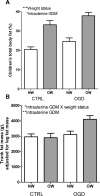Overweight status and intrauterine exposure to gestational diabetes are associated with children's metabolic health
- PMID: 22308218
- PMCID: PMC3269827
- DOI: 10.1111/j.2047-6310.2011.00009.x
Overweight status and intrauterine exposure to gestational diabetes are associated with children's metabolic health
Abstract
Background: Offspring of women with gestational diabetes (OGD) have greater risk for obesity and impaired metabolic health. Whether impaired metabolic health occurs in the absence of obesity is not clear.
Objective: The purpose of this study was to investigate the independent and interactive effects of intrauterine exposure to gestational diabetes and of children's current weight status on their metabolic health.
Methods: Children aged 5–10 years (n = 51) with and without intrauterine exposure to gestational diabetes (OGD vs. offspring of non-diabetic women [CTRL]) were grouped into normal weight (body mass index [BMI] < 85th %) and overweight (BMI > 85th %) according to Centers for Disease Control growth curves. Lipid profile was obtained by fasting blood draw, insulin sensitivity (SI) and secretion by liquid meal tolerance test, and body composition by dual-energy X-ray absorptiometry.
Results: Despite similar average BMI percentiles among normal weight OGD versus CTRL, and overweight OGD vs. CTRL, OGD had greater total %fat and trunk fat adjusted for leg fat compared with CTRL (P < 0.05). Overweight children had lower SI (P < 0.05) and greater basal, static, and total insulin secretion independent of SI (P < 0.05). OGD was independently associated with greater static insulin secretion (P < 0.05) and the interaction between OGD and overweight was associated with greater basal insulin secretion independent of SI (P < 0.01). OGD and overweight were each associated with lower high-density lipoprotein-cholesterol (HDL-C) (P < 0.05).
Conclusion: Intrauterine exposure to gestational diabetes was associated with greater central adiposity and insulin secretion, and lower HDL-C, irrespective of current weight status. Future research should examine respective contributions of the intrauterine environment and of underlying genotype on children's metabolic health.
Keywords: body composition; glucose; insulin; lipid; obesity; pediatric; pregnancy; prenatal programming.
Figures



References
-
- Centers for Disease Control and Prevention . National diabetes fact sheet: national estimates and general information on diabetes and prediabetes in the United States, 2011. U.S. Department of Health and Human Services; Atlanta, GA: 2011.
-
- Dabelea D, Snell-Bergeon JK, Hartsfield CL, Bischoff KJ, Hamman RF, McDuffie RS. Increasing prevalence of gestational diabetes mellitus (GDM) over time and by birth cohort: Kaiser Permanente of Colorado GDM Screening Program. Diabetes Care. 2005;28:579–584. - PubMed
-
- Dooley SL, Metzger BE, Cho N, Liu K. The influence of demographic and phenotypic heterogeneity on the prevalence of gestational diabetes mellitus. Int J Gynaecol Obstet. 1991;35:13–18. - PubMed
-
- Gillman MW, Rifas-Shiman S, Berkey CS, Field AE, Colditz GA. Maternal gestational diabetes, birth weight, and adolescent obesity. Pediatrics. 2003;111:e221–226. - PubMed
-
- Boney CM, Verma A, Tucker R, Vohr BR. Metabolic syndrome in childhood: association with birth weight, maternal obesity, and gestational diabetes mellitus. Pediatrics. 2005;115:e290–296. - PubMed
Publication types
MeSH terms
Substances
Grants and funding
LinkOut - more resources
Full Text Sources
Other Literature Sources
Medical

